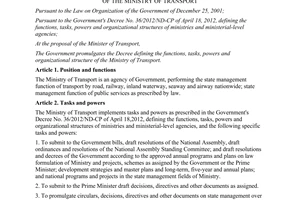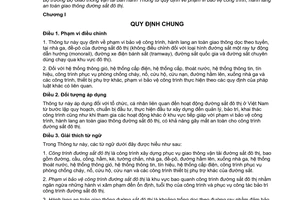Nội dung toàn văn Circular 37/2014/TT-BGTVT safe clearance distances and safety corridors of urban railroads
|
MINISTRY
OF TRANSPORT |
SOCIALIST
REPUBLIC OF VIETNAM |
|
No. 37/2014/TT-BGTVT |
Hanoi, September 03, 2014 |
CIRCULAR
SAFE CLEARANCE DISTANCES AND SAFETY CORRIDORS OF URBAN RAILROADS
Pursuant to the Law on Railway transport No. 35/2005/QH11 dated June 14, 2005;
Pursuant to the Government's Decree No. 107/2012/ND-CP dated December 20, 2012, defining the functions, tasks, entitlements and organizational structure of the Ministry of Transport;
At the request of Director of Department of Transport Infrastructure and Director of Vietnam Railway Administration,
The Minister of Transport promulgates a Circular on safe clearance distance and corridor of urban railroads.
Chapter I
GENERAL PROVISIONS
Article 1. Scope
1. This Circular provides for safe clearance distance and safety corridor along the railway, at the stations and depots of urban railway (excluding monorail, tramway, national railway and dedicated railway running through urban areas).
2. Relevant laws shall apply to ventilation, power supply, water supply and drainage, communication, signalling systems, fire safety works, rescue equipment, subway entrance and exit, auxiliary works and devices, safe clearance distances.
Article 2. Regulated entities
This Circular applies to organizations and individuals involved in urban railway transport in Vietnam, including planning, investment preparation, investment, management, maintenance, operation and other activities in the vicinity of the safe clearance distance and safety corridor of urban railway that may threaten the safety of urban railway transport.
Article 3. Definitions
For the purpose of this Circular, the terms below are construed as follows:
1. “urban railway work” means a work serving urban railway transport, including bridges, drains, tunnels, embankments, stations, depots, entrances and exits, water drainage, ventilation, communication, signaling, power supply systems, fire safety works, rescue equipment and other auxiliary railway works.
2. “safe clearance distance” means a mandatory distance from the urban railway work meant to prevent infringement that may affect the stability, lifespan of the works and serve maintenance of urban railway.
3. “safety corridor” means the empty area along the rail meant to ensure safety of train operation and facility rescue.
4. “depot” means the area where trains are assembled, gathered, maintained, repaired and where other tasks are performed.
5. “station” means the place where the train stops to load or unload passengers; where essential services are provided for passengers and where machinery and equipment serving train operation are installed.
6. “block” means the rail that connects two stations.
7. “forbidden area” means the area around the tunnel in which other works must not be built in order to avoid affecting stability and lifespan of the urban railway work.
8. “restricted area” means the area above or outside the forbidden area in which other construction of new or repair of works must be strictly controlled in order to avoid affecting stability and lifespan of the urban railway work.
Article 4. General rules
1. The safety corridor within a block between two stations is always within the safe clearance distance from the rail. The outer most boundary of the safety corridor is the same as the safe clearance distance.
2. The scope of the safe clearance distance varies according to the level of the rail (elevated, underground or surface rails); according to available land area approved by the authority that permits the construction of the railway line, but shall not fall below the values specified in this Circular.
3. The safe clearance distance shall:
a) ensure safety of the railway work and train operation;
b) facilitate maintenance and rescue where necessary;
c) minimize land use.
4. New constructions and installation of equipment serving other purposes are not permitted within the urban railway safe clearance distance; intrusion and other acts that affect stability and lifespan of urban railway works and train operation safety are prohibited.
5. When building, renovating or upgrading a construction work within the safe clearance distance, the owner must reach an agreement with its supervisory body and obtain a construction license as prescribed by law.
6. The land area below elevated urban rail and rail bridge may be used for road traffic provided road safety and urban landscape are ensured and permission is granted by a competent authority.
Chapter II
SAFE CLEARANCE DISTANCE OF URBAN RAILWAY WORKS
Section 1. SAFE CLEARANCE DISTANCES OF ELEVATED URBAN RAILWAY WORKS
Article 5. Safe clearance distance at blocks
1. The minimum vertical safe clearance distance is 2 m from the highest point of the bridge and:
a) 6.3 m from the top of the rail if power is supplied by overhead wires;
b) 4.3 m from the top of the rail if power is supplied by a third rail.
2. The minimum horizontal safe clearance distance is 3 m from the outer most edge of the bridge to the sides.
Article 6. Safe clearance distance at stations
1. The minimum vertical safe clearance distance is 2 m from the highest point of the station.
2. The minimum horizontal safe clearance distance is 3 m from the outer most boundary of the station.
3. In the cases where a station is part of a multi-purpose complex, the safe clearance distance of the station is the boundary of the entire work and space of the station.
Section 2. SAFE CLEARANCE DISTANCES OF URBAN RAILWAY WORKS AT GROUND LEVEL
Article 7. Safe clearance distance at blocks
1. The vertical safe clearance distance is the same as that specified in Clause 1 Article 5 of this Circular.
2. Minimum horizontal safe clearance distances:
a) For rail embankment: 3 m from the bottom of the embankment or outer edge of the wall to the sides (see Figure 1 in Appendix I hereof);
b) For rail trench: 3 m from the top of the trench or the wall to the sides (see Figure 2 in Appendix I hereof);
c) For surface rail: 6.1 m from the centerline to the sides (see Figure 3 in Appendix I hereof).
3. The vertical safe clearance distance of bridges shorter than 20 m is specified in Figure 4 in Appendix I hereof; vertical safe clearance distance of bridges of ≥ 20 m is the same as that specified in Clause 2 Article 5 of this Circular.
Article 8. Protection area at stations
1. The safe clearance distance of a surface station is the same as that specified in Article 5 of this Circular.
2. Walls or fences (if any) of the station indicate its safe clearance distance.
Article 9. At depots
The safe clearance distance of a depot is indicated by its fences and landmarks.
Section 3. SAFE CLEARANCE DISTANCES OF UNDERGROUND URBAN RAILWAY WORKS
Article 10. Safe clearance distances of underground urban railway works
1. The safe clearance distance of an underground urban railway work covers its forbidden area and restricted area.
2. No other construction works are allowed within the forbidden area.
3. When building, renovating or upgrading a construction work within the restricted area, the owner comply with provisions of Clause 5 Article 4 of this Circular.
4. Safe clearance distances of underground urban railway works are specified in Figure 5, Figure 6 and Figure 7 in Appendix II hereof.
Article 11. Forbidden area
The forbidden area is the land area around the tunnel, has a rectangle cross-section and is determined as follows:
1. For round tunnel, the distance between the edges of the forbidden area and the top and bottom of the tunnel is the same as the diameter of the tunnel; the distance between the edges of the forbidden area and the sides of the tunnel is half the diameter of the tunnel.
2. For rectangle tunnel, the distance between the edges of the forbidden area and the top and bottom of the tunnel is 6 m; the distance between the edges of the forbidden area and the sides of the tunnel is 3 m.
3. Other types of tunnels will apply the requirements of round or rectangle tunnels according to their shapes.
Article 12. Restricted area
1. The restricted area is the land area above and outside the forbidden area, has the shape of a trapezium whose bottom edge divides the restricted area and top edge is the natural surface. Dimension of the top edge:
a) Within a block: 30 m from the centerline of the tunnel to the sides;
b) At underground station: 40 m from the centerline of the tunnel to the sides.
2. If the underground station is part of a multi-purpose complex, its safe clearance distance is the boundary of the entire work and space of the station.
Section 4. SAFE CLEARANCE DISTANCES OF URBAN RAILWAY WORKS IN SPECIAL CASES
Article 13.
1. In the cases where the safe clearance distance of an urban railway work and road safety corridor overlap, the minimum distance between the edges of two works is 0.1 m. The works that are built afterwards must be reinforced to ensure public safety.
2. In case of a historic site that cannot be relocated or extreme difficulties in land clearance, the safe clearance distance of the urban railway work at such location may be decreased. To be specific:
a) For elevated railway: the minimum distance between the edge of the railway work to the safety perimeter of the historic site is 0.1 m;
b) For surface railway: the minimum distance between the edge of the railway work to the safety perimeter of the historic site is 3.1 m;
c) Notwithstanding provisions of Clause 2a and Clause 2b of this Article, the construction of an urban railway work that is adjacent to a historic site must comply with regulations of law on cultural heritage.
3. The person that decided the investment in the urban railway project shall assume responsibility for the cases mentioned in Clause 1 and Clause 2 of this Article and shall take technical measures to avoid affecting the stability and lifespan of the work.
Chapter III
MANAGEMENT AND PROTECTION OF URBAN RAILWAY WORKS
Article 14. Protection
Protection of urban railway works shall comply with the Law on Railway transport and relevant regulations of law.
Article 15. Responsibility for management and protection
Responsibility for management and protection of urban railway works shall comply with Articles 7, 8, 36, 61, 80 of the Law on Railway transport.
Chapter IV
IMPLEMENTATION
Article 16. Effect
This Circular comes into force from November 01, 2014.
Article 17. Transition clauses
Safe clearance distances of urban railway works that are granted approval before the effective date of this Circular shall comply with provisions of the decision on approval.
Article 18. Implementation
1. Chief of the Ministry Office, the Ministerial Chief Inspector, Directors of Departments, Director of Vietnam Railway Administration, Director of Vietnam Railways Corporation, Chief of Traffic Safety Board, Director of Departments of Transport of provinces, relevant organizations and individuals are responsible for implementation of this Circular.
2. Difficulties that arise during the implementation of this Circular should be reported to the Ministry of Transport for consideration./.
|
|
MINISTER |
APPENDIX I
HORIZONTAL SAFE CLEARANCE DISTANCE OF SURFACE URBAN RAILWAY WORKS
Figure 1: Rail embankment
|
|

Figure 2: Rail trench

Figure 3: Flat rail
HORIZONTAL SAFE CLEARANCE DISTANCEs OF BRIDGES SHORTER THAN 20 METERS
(from the end of one abutment to another)
|

Figure 4
APPENDIX II
SAFE CLEARANCE DISTANCES OF UNDERGROUND URBAN RAILWAY WORKS

Figure 5: Round tunnel

Figure 6: Rectangle or square tunnel
SAFE CLEARANCE DISTANCES OF UNDERGROUND STATIONS

Figure 7


